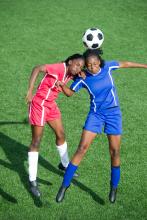
Decision tree
Where does all of this lead parents and middle school and Under-14 youth soccer programs?
In answering the question, "Should my child head soccer balls?" (for parents, at least) Webbe proposes in his 2010 book [2] the use of the following "decision tree":
Should My Child Head Soccer Balls?
| If Yes to ALL: OK with Caution | If Yes to ANY: NO |
| 13 or older | Under 13 |
| Proportional musculature for head size | Large head relative to body |
| No history of head injury | Positive history of head injury |
| Has had technical heading instruction from a qualified coach | No technical heading instruction from a qualified coach |
| No history of learning or attention problems | Positive history of learning or attention problems |
As Webbe notes, however, while this decision tree is useful for individual children, it "does not address the practical application of such a decision matrix. Clearly, it would be awkward at best and chaotic at worse to allow some children on a team to head and not others."
In his view, a ban on heading for all children would thus be the best practical solution.
As for middle-school and U14 soccer programs, time will tell whether the science will prove him and CLI right. For now, however, one thing is clear, and that is that the science is far from clear: that the evidence simply does not permit an unqualified answer to the question of whether heading a soccer ball results in more concussions and repeated subconcussive brain trauma which can have long-term neurological consequences in both adolescents and adults, much less that delaying heading until age 14 will result in fewer concussions and measurably less long-term neurological consequences for those who delay heading versus those who don't.
Adding fuel to fire
The decision by the United States Soccer Federation ("USSF") in November 2015 to ban heading in programs under its control for soccer players 10 and under and to limit heading in practice for those ages 12 and 13, and to recommend to other youth soccer organizations that heading in practices or games be banned at the U11 level and younger, and that heading in training at the U12 and U13 be limited to a maximum of 30 minutes per week, with no more than 15 to 20 headers per player per week, adds considerable fuel to the fire of the debate over heading in soccer, with experts quickly lining up on both sides.
Commenting by email, Dawn Comstock, the author of the 2015 study on heading in scocer,[47] stated that, "As always, I support any and all efforts to keep young kids as safe as possible while playing sports, so, in general, I support the new U.S. Soccer initiative."
But Comstock expressed four concerns. First, she wondered "what effort will be made to educate all those affected by the recommendations but not actually included in the requirement?" Second, she had concerns about enforcement and feasibility: "who will enforce these new regulations and what will be the penalty for violating them, and from a feasibility [standpoint], who will be counting how many headers each athlete takes in each practice and where/how will that be recorded and referred to?
Third, Comstock questioned the rationale for limiting heading in practice for 12- and 13-year-olds but allowing heading in games. "This is completely backward from an injury prevention perspective," she said, "since concussion rates are significantly higher in competition and because we want young athletes to learn proper technique in the controlled practice environment."
Finally, fourth, Comstock reitterated her view that there was "no strong scientific evidence for these age cut points."
Likewise critical of U.S. Soccer's actions was Chris Koutures, the lead author of the AAP youth soccer clinical report.[21]"There is no evidence-based, peer-reviewed literature to support a ban on heading at age 11 versus age 14, versus any age for that matter. When the American Academy of Pediatrics Council on Sports Medicine and Fitness looked at the introduction of heading in youth soccer, we concluded that it "only be taught when the child is willing to learn proper technique and has developed coordinated use of his or her head, neck, and trunk to properly contract the neck muscles and contact the ball with the forehead." This came from consensus opinion of our members, not from any direct study interpretation.
So, "as for the ban on heading U11 and under" is concerned, Koutures was "fairly OK with that, [because] most kids [at] those ages tend to shy away from balls in the air and I can't fathom most kids U11 and under [being] able to muster the ability to protect themselves and initiate coordinated head, neck and trunk action." As a result, said Koutures, that U.S. Soccer came out against heading U11 "is fairly consistent with our AAP recommendations."
Having said, however, Koutures viewed the practice limitations in heading at U12 and U13 as "arbitrary" and without "roots in evidence-based studies." They may prove to be a "good start" or "we may learn down the road that even those restrictions may allow too much exposure." The fact is, he said, that we "just don't have that supporting knowledge at this time."
Koutures also expressed concern that people will look strictly at the numbers of headers taken in practice and not watch the kid. He cited as an example pitch counts in baseball, which while well-intentioned, sometimes cause some parents/coaches to focus just on the number of pitches, without observing the pitcher's performance on the field. "There is no apparent concern about fatigue [as long as] the pitcher is 'under his limit', even if his pitches are way out of the strike zone, he is grimacing on every throw and shaking his arm between pitches." Koutures cautioned that, when heading is introduced, "it will be important to look not just at numbers. but on how the kid is approaching and relating to the ball. Any evidence of shying away or hesitation, forget the number, that session should be done."
That the new U.S. Soccer guidelines on heading in soccer make no mention of the importance of neck strengthening, Koutures said was "disappointing, as again, if the goal is to protect kids, then publicizing the emerging and growing body of literature that supports neck strengthening would be quite sensible." "The realist is me grudgingly must admit that even with great data and programs (on-line, free, evidence-based) for ACL injury reduction, adoption has been quite dismal, and perhaps that's in part why neck strengthening could suffer the same fate and thus not be as attractive to promote."
Also critical of the new soccer heading rules, but for different reasons, was Michael Kaplen, an attorney who represents concussion victims and teaches brain injury law at George Washington University Law School, who told NBC News[50] that the new rules were actually a bad idea. The age limits seemed "arbitrary" and "stupid," Kaplen said. He advocates a complete ban for youth players.
And they make it seem like U.S. soccer officials found a fix, he said.
"These leagues are trying to solve a concussion problem by creating rules that give people a false sense of security," Kaplen said. "By creating rules, they imply they have addressed and solved this problem, which they have not."
Praise for soccer heading ban
Commenting on the new rules in the same NBC News article[50], CLI's Nowinski said the new rules fell short because they left middle school-age players vulnerable.
"From that perspective, we still have a ways to go," Nowinski, said.
But Nowinski also told NBC News that it was a good sign that U.S. Soccer that willing to draw a line somewhere. "For soccer to even set an age is a big step," he said.
Concussion Legacy Institute co-founder Cantu predicted that the new rules would cut the number of concussions among the youngest players and shorten the time when those children are at risk for experiencing "sub-concussive hits" that can cause brain injuries later.
Children between the ages of 10 and 12 are most susceptible to concussions because their brains are underdeveloped and their necks are not strong enough, Cantu said.
By delaying the introduction of headers, Cantu asserted, U.S. Soccer "is avoiding the most injurious time period for the brain - and you're also shortening the total amount of trauma somebody takes," he said.
________
* In the interest of transparency, and to avoid any suggestion of bias in reporting this story, it should be noted that Dr. Comstock, Professor Webbe, and Dr. Koutures are uncompensated members of MomsTEAM Institute's Board of Advisors, which is developing best practice youth sports health and safety checklists, including youth soccer, for the Institute's SmartTeamTM program. It remains to be seen where the Institute will ultimately come down on the issue of the age at which heading in soccer can safely begin, or whether, as banning heading is the best way to reduce concussions at the youth level, as SLI proposes and Professor Webbe supports, or via better rules enforcement, enhanced education of players, and better coaching, as Dr. Comstock recommends.
1. Lipton M, Kim N, Zimmerman M, Kim M, Stewart W, Branch C, Lipton R. Soccer Heading Is Associated with White Matter Microstructural and Cognitive Abnormalities. Radiology 2013;DOI:10.1148/radiol.13130545.
2. Webbe, FM, & Salinas, C. (2010) The relationship of soccer heading and neuropsychological functioning: When Science and Politics Collide. In F.M. Webbe (Ed.). Handbook of Sport Neuropsychology (pp. 275-294). New York: Springer Publishing Company.
3. Webbe FM. (2006). Definition, physiology, and severity of cerebral concussion. In R. J. Echemendia (Ed.), Sports neuropsychology: Assessment and management of traumatic brain injury (pp. 45-70). New York: The Guilford Press.
4. Webbe, FM. & Ochs, SR. Recency interacts with frequency of soccer heading to predict weaker neuro-cognitive performance. Applied Neuropsychology 2003;10:31-41.
5. Webbe FM. & Ochs SR. Personality traits related to heading frequency in male soccer players. J Clin Sp Psychol 2007;1:379-389.
6. Witol AD. & Webbe FM. Soccer heading frequency predicts neuropsychological deficits. Arch Clin Neuropsychol 2003;18: 397-417.
7. Henry C, Tremblay J, Tremblay S, Lee A, Brun C, Lepore N, Theoret H, Ellemberg D, Lassonde M. Acute and Chronic Changes in Diffusivity Measures after Sports Concussion. J Neurotrauma 2011;28(10): 2049-2059.
8. Tysvaer A, Storli O. Association football injuries to the brain: A preliminary report. Br J Sports Med 1981:15:163-166.
9. Sortland O, Tysvaer A. Damage in former association football players: An evaluation by cerebral computed tomography. Neuroradiology 1989;31:44-48.
10. Tysvaer A, Storli O, Bachen N. Soccer injuries to the brain: A neurologic and electroencephalographic study of former players. Acta Neurologica Scandinavica 1989;80:151-156.
11. Tysvaer A, Lochen E. Soccer injuries to the brain: A neuropsychologic study of former soccer players. Am J Sports Med 1991;19:56- 60.
12. Tysvaer A. Head and neck injuries in soccer: Impact of minor trauma. Sports Medicine 1992:14:200-213.
13. Abreau F, Templer D, Schuyler B, Hutchison H. Neuropsychological assessment of soccer players. Neuropsychology 1990;4:175-181.
14. Matser J, Kessels A, Jordan B, Lezak M, Troost J. Chronic traumatic brain injury in professional soccer players. Neurol 1998;51: 791-796.
15. Matser J, Kessels A, Lezak M, Jordan B, Troost J. Neuropsychological impairment in amateur soccer players. JAMA 1999;282: 971-973 (amateur soccer players found to have diminished ability on tests of memory and planning).
16. Barnes B, Cooper L, Kirkendall D, McDermott T, Jordan B, Garrett W. Concussion history in elite male and female soccer players. The
Am J Sports Med 1998;26:433-438.
17. Guskiewicz K, Marshall S, Broglio S, Cantu R, Kirkendall D. No evidence of impaired neurocognitive performance in collegiate soccer
players. Am J Sports Med 2002;30(2):157-162.
18. Kirkendall D, et al. Heading in soccer: Integral skill or grounds for cognitive dysfunction? J Ath Tr 2001;36:328-333.
19. Spear,J. Are professional footballers at risk of developing dementia? Int'l J Geriatric Psych 1995;10:1011-1014.
20. Rutherford A, Stephens R, Potter D. The neuropsychology of heading and head trauma in association football (soccer): A review. Neuropsychol Rev 2003;13:153-179.
21. Koutures C, Gregory A, and The Council on Sports Medicine and Fitness. Clinical Report: Injuries in Youth Soccer. Pediatrics 2010;125:410-414. Reaffirmed May 2014 (http://pediatrics.aappublications.org/content/132/1/e281.full)
22. Spiotta A, Bartsch A, Benzel E. Heading in Soccer: Dangerous Play? Neurosurgery 2012;70(1):1-11.
23. Fakhran S, Yaeger K, Alhilali L. Symptomatic White Matter Changes in Mild Traumatic Brain Injury Resemble Pathologic Features of Early Alzheimer Dementia. Radiology 2013. DOI:10.1148/radiol.13122343.
24. Janda D, Bir C, & Cheney A. An evaluation of the cumulative concussive effect of soccer heading in the youth population. Injury Control and Safety Promotion 2002;9(1), 25-31.
25. Salinas C, Webbe F, & Devore T. The epidemiology of soccer heading in competitive youth players. J Clin Sport Psychol 2009;3:1-20.
26. Stephens R, Rutherford A, Potter D, & Fernie G. Neuropsychological impairment as a consequence of football (soccer) play and report on school students (13-16 years). Child Neuropsychol. 2005;11:513-526.
27. Barnes B, Cooper L, Kirkendall D, McDermott T, Jordan B, & Garrett W. Concussion history in elite male and female soccer players. Am J Sports Med 1998;26:433-438.
28. Dezman Z, Ledet E, Kerr H. Neck Strength Imbalance Correlates With Increased Head Acceleration in Soccer Heading. Sports Health: A Multidisciplinary Approach 2013; 20(10). DOI: 10.1177/1941738113480935 (published online ahead of print March 20, 2013)(accessed March 21, 2013).
29. Cantu R (2012). Concussions and Our Kids. New York: Houghton Mifflin Harcourt
30. Oulette J. Is heading safe? http://www.ayso.org/resources/safety/is_heading_safe.aspx. (accessed March 20, 2013).
31. Meehan WP, III, (2011). Kids, Sports & Concussion. Santa Barbara: Praeger
32. Small G, Kepe V, Siddarth P, Ercoli LM, et al PET Scanning of Brain Tau in Retired National Football League Players: Preliminary Findings. Am J Geriatr Psych 2013;21:138-144.
33. Van Jones SA, Breakley RW, Evans PJ. Heading in football, long-term cognitive decline and dementia: evidence from screening retired professional footballers. Br J Sports Med. 2014;48:159-161, doi:10.1136/bjsports-2013-092758.
34. Gutierrez GM, Conte C, Lightbourne K. The relationship between impact force, neck strength, and neurocognitive performance in soccer heading in adolescent females. Pediatric Exer Sci. 2014;26:33-40.
35. Collins CL, Fletcher EN, Fields SK, Kluchurosky L, Rohrkemper MK, Comstock RD, Cantu RC. Neck Strength: A Protective Factor Reducing Risk for Concussion in High School Sports. J Primary Prevent. 2014; DOI:10.1007/s10935-014-03555-2 (published online ahead of print June 15, 2014)
36. Cobb BR, Urban JE, Davenport EM, Rowson S, Duma SM, Maldjian JA, Whitlow CT, Powers AK, Stizel JD. Head Impact Exposure in Youth Football: Elementary School Ages 9-12 Years and the Effect of Practice Structure. Ann Biomed Eng ( 2013): DOI: 10.1007/s10439-013-0867-6 (online ahead of print)
37. Kontos P, Fazio V, Burkart S, Swindell H, Marron J, Collins M. Incidence of Sport-Related Concussion among Youth Football Players Aged 8-12 Years. J Pediatrics 2013. DOI 10.1016/j.jpeds.2013.04.011
38. Sports Legacy Institute, "US Women's Soccer Legend Brandi Chastain, Sports Legacy Institute and Santa Clara Institute of Sports Law and Ethics Launch Educational Campaign on Concussions and the Risks of Heading In Soccer Before High School." (press release; June 25, 2014)(http://www.sportslegacy.org/wp-content/uploads/2014/06/Soccer-Heading-Pr...)(accessed August 2, 2014).
39. Cantu R, Nowinski C, Robbins C. White Paper: The Neurological Consequences Of Heading In Soccer. Sports Legacy Institute (undated)(http://www.sportslegacy.org/wp-content/uploads/2014/07/Soccer-Heading-Wh...)(accessed August 2, 2014)
40. Bowen J. "The Ethics of Headers in Youth Soccer: Using Our Heads Correctly." Santa Clara Institute of Sports Law & Ethics (July 24, 2014)(http://law.scu.edu/sports-law/the-ethics-of-headers-in-youth-soccer-usin...)(accessed August 2, 2014)
41. Stephens R, Rutherford A, PotterD, Fernie G. Neuropsychological consequences of soccer play in adolescent U.K. school team soccer players. J Neuropsychiatry and Clin Neuroscience 2010;22:295-303.
42. Rieder C, Jansen P. No neuropsychological consequence in male and female soccer players after a short heading training. Arch Clin Neuropsychol. 2011;26:583-591.
43. O'Kane J, Spieker A, Levy MR, Neradilek M, Polissar NL, Schiff MA. Concussions Among Female Middle-School Soccer Players. JAMA Pediatr. 2013;doi:10.1001/jamapediatrics.2013.4518 (published online January 20, 2014).
44. Zhang MR, Red SD, Lin AH, Patel SS, Sereno AB. Evidence of Cognitive Dysfunction after Soccer Playing with Ball Heading Using a Novel Tablet-Based Approach. PLOS One. 2013;DOI: 10.137/journal.pone.0057364 (accessed August 2, 2014)
45. Marar M, McIlvain NM, Fields SK, Comstock RD. Epidemiology of Concussions Among United States High School Athletes in 20 Sports. Am J Sports Med. 2012;40(4):747-755
46. American Academy of Pediatrics' Council on Sports Medicine and Fitness. Position Statement: Reducing Injury Risk from Body Checking in Boys' Youth Ice Hockey. Pediatrics. 2014;133:11151;originally published online May 26, 2014;doi:10.1542/peds.2014-0692.
47. Comstock RD, Currie DW, Pierpoint LA, Grubenhoff JA, Fields SK. An Evidence-Based Discussion of Heading The Ball And Concussions in High School Soccer. JAMA Pediatrics 2015; doi:10.1001/jamapediatrics.2015.1062 (publilshed online July 13, 2015)
48. http://www.sportslegacy.org/policy/safer-soccer/ (last visited July 16, 2015)
49. Reynolds, G. Heading Ban for Youth Soccer Won't End Head Injuries. New York Times. July 15, 2015 (http://well.blogs.nytimes.com/2015/07/15/heading-ban-for-youth-soccer-wo... (accessed July 16, 2015).
50. Jon Schuppe. "Will Soccer's New Header Rules Make Kids Safer?" www.NBCNews.com. November 10, 2015 (accessed at http://www.nbcnews.com/news/us-news/will-soccers-new-header-rules-make-k...)



